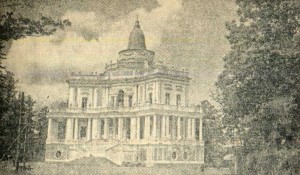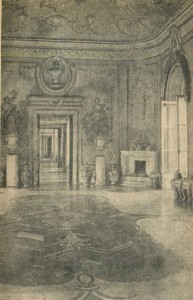In 1962 the people of Lomonosov celebrated the 250th anniversary of the foundation of the town and of the birthday of the great encyclopaedic scientist M. V. Lomonosov, whose name was given to the town formerly called Oranienbaum.
The history of the town’s foundation is closely connected with the liberation of the Baltic Coast from the Swedish colonizers by Russian armies. After the foundation of the Peter and Paul Fortress had been laid, Peter I fixed his attention on making beautiful the surroundings of St. Petersburg. In 1707 he gave the estate, where the town of Lomonosov now stands, to A. D. Menshikov, one of his associates. With Kronstadt and Peterhof so close by, Menshikov was inspired to begin building the Grand Palace with a park. Menshikov called his estate Oranienbaum (which means a wild orange tree).
In fifteen years (1711—1725) Oranienbaum was transformed into a splendid princely residence. The palace, built by the architects G. Shedel and M. Fontana on the cliffs, was the most notable piece of architecture in its day. In front of the palace, on the deserted shore of the Gulf of Finland, was laid out the Nizhny Park (Lower Park) decorated with statues, fountains, green-houses and a menagerie. Its geometrically strict lay-out (the so-called ‘regular style’) was completed by an artificial canal which, according to tradition, had been dug by 9,000 serfs within three days.
In 1743 Elizabeth gave Oranienbaum to her nephew, the heir to the Russian throne, later Peter III.
The most important additions of the 1740’s are the Stone Hall (attributed to the architect V. Rastrelli) and the Opera House which has a richly painted interior. In 1746 in front of the palace was erected the so-called Poteshnaya Krepost (a small fortress built for the young Peter to play in), and in 1756—1762 a real fortress Peterstadt was erected. The work was directed by Russian engineers and craftsmen.
From 1756 the building at Oranienbaum was under the supervision of the architect A. Rinaldi. He designed the Palace of Peter III (1758—1762) which stands on the high right bank of the river Karost, in the eastern half of the Verkhny Park (Upper Park). This two-storey house was built by the Russian master-builder Vasily Petrov and his fellow-workers. The interiors of the palace were exquisitely decorated with carvings, moulded tracery and murals and hung with tapestries. Much of the painting on the panels and doors was done by the artist F. Vlasov.
After the great restoration work was accomplished (in 1952—1953 and later on in 1959—1960), the palace — now a historic and art museum — was opened to the public. The decorative ensemble of Oranienbaum was completed during the first years of Catherine Il’s reign. The Country-house with its famous Chinese Palace and Katdlnaya Gorka (an artificially-made hill for tobogganing) were erected specially for the empress.
Built in 1762—1768 by the architect A. Rinaldi, the Chinese Palace, like most of the architecture of that period, is characteristic of the gradual transition from baroque splendour to the natural simplicity of classicism. People who come to the palace are amazed by the exquisite decoration of the rooms: the murals, the picturesque paintings on the panels,’, the dainty moulded tracery, the embroidery and, finally, the parquet flooring composed of thin strips of valuable kinds of hardwood. All this work was done by Russian craftsmen, and Italian and Venetian artists. The names of the gilders Savva Trofimov, Ivan Sokolov and Ivan Trofimov, of the painters Stefano Terelli and Serafino Barozzi, as well as of the Venetian artists Tiepolo, Pittoni and Dizziano will remain in history. Perhaps, the finest room is the Bugle-bead Room, the floor of which is a mosaic of smalt.
The art of manufacturing coloured smalt (a kind of glass) which previously existed only in the ancient East was revived in Russia by the great scientist M. V. Lomonosov. He found the right composition of ingradients for making smalt and established a workshop for the preparation of mosaics.
The Ust-Ruditskaya factory, founded by M. V. Lomonosov for making bugles, glass-beads and smalt, was opened 24 kilometres from Oranien-baum in 1754. The scientist invented machines and special tools for the factory. He also supervised the installation of the furnaces and took part in working out the technology. The smalt for the Chinese Palace was made here, too.
To commemorate the great scientist’s life and work in this district, Oranienbaum was renamed Lomonosov in 1948.
The smalt floor in the palace was laid by the Russian mosaic craftsmen Kuzma Kotelnikov, Fyodor Biryukov, Dmitry Gorchakov, Andrei Ko-novin and others, sent from the Peterhof lapidary factory. Unfortunately, the smalt floor survived only until 1891, when it was replaced by a wooden copy.
After the great restoration work was finished (1956—1958), the exquisite architecture of the white-and-blue Katdlnaya Gorka situated in the north-west part of the Upper Park again became a pleasure to the eye. Such pavilioni-gorki were 18th century constructions of purely Russian origin, popular places of entertainment during the people’s festivities. Since 1958 thousands of people have visited this remarkable museum, a memorial to Russian art.
The history of building at Oranienbaum in the 19th century was marked by the work of the architects V. P. Stasov, A. N. Melnikov, E. A. Preis, A. A. Mikhailov and A. M. Gornostaev.
The names of many outstanding Russian men of science and culture are connected with the town of Lomonosov.
In the spring of 1829 A. S. Pushkin visited Oranienbaum, and later, in the summer of the same year, the poet A. A. Delvig — a friend of Pushkin in his Lyceum days — also came here.
In 1860—1880 N. A. Nekrasov and M. E. Saltykov-Shchedrin used to come to the former estate Bogumilovka (Bogumilovskaya Ulitsa, Nos. 4, 8 and 10), the home of the engineer A. E. Yerakov, their friend and contributor to the magazine Otechestvenniye Zaplski.
At different times many prominent people lived and worked at Oranienbaum, among them the poet P. A. Vyazemsky, the surgeon N. I. Pirogov, the critic V. V. Stasov, the composer M. P. Musorgsky, the actors M. G. Savina, V. N. Davidov, M. N. Yermolova and G. N. Fedotova.
The town of Lomonosov is not only a monument of the history of art but also of the history of the Revolution.
In the years of the Civil War, when the interventionists supported by the White Guards took the offensive against Petrograd, the forts of Krdsnaya Gorka and Seraya Loshad took up arms against Russian power in May 1919. The Bolshevik Party, the People’s Government and the Petrograd Party organization directed all the revolutionary forces to suoress the revolt, a mortal danger that threatened Kronstadt. At Oranien-baum (Parokhddnaya Dlitsa, No. 5, now No. 7 a conference of commanders and commissars of the armed detachments of the Red Guards was held on June 14. The conference drew up a plan for capturing the forts, and the plan was successfully carried out.
In the square in front of the Lomondsov railway station there is a granite monument erected in memory of the communists of the garrisson of Krasnaya Gorka who were shot down by the White Guards.
During the Great Patriotic War Oranienbaurn became a stronghold of the Army and Baltic Fleet defending the approaches towards Kronstadt and the City of Lenin. The fight for Oranienbaumsky Pyatachok is a glorious page in the annals of war. It was here that the decisive blow against the fascist troops was prepared. From here the Russiantroops who had crushed the fascist hordes and had broken the ring of the Saint Petersburg blockade started their offensive.

Katdlnaya Gorka in the town of Lomonosov: one of the numerous park pavilions restoied by Russian architects and builders.







